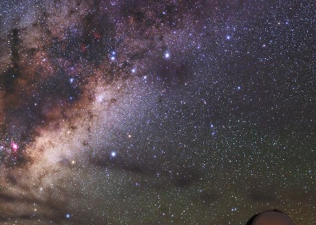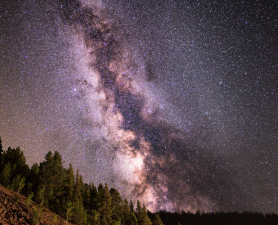The Milky Way is the galaxy we inhabit, composed of tens of billions of stars, interstellar gas, and dust, arranged in a spiral disk. However, scientists have discovered that the Milky Way is not a perfectly flat surface, but rather exhibits significant distortion and splay. The cause of this anomaly remained a mystery until recently, when a new study may reveal the answer: a vast, invisible, tilted halo of dark matter.
Basic Overview of the Milky Way
The Milky Way, also known as the "Milky Way," is the galaxy in which our solar system resides. According to astronomical research, the Milky Way is a spiral galaxy, containing tens to hundreds of billions of stars. Its diameter is approximately 100,000 light-years, meaning that light would take 100,000 years to travel this distance in a vacuum.
The center of the Milky Way, located toward the constellation Cygnus, is densely packed with a supermassive black hole, Sagittarius A*. The Milky Way's disk is vast, containing a vast number of stars, planets, nebulae, star clusters, and dust, making it an extremely complex and vast celestial system.
A Detailed Explanation of the Milky Way's "Immense Size"
- Diameter: 100,000 Light-Years
To put it in numbers, the Milky Way's diameter is approximately 100,000 light-years. This means that it would take light 100,000 years to travel from one end of the galaxy to the other. With our current level of technology, no man-made spacecraft can traverse such a vast distance in a reasonable time.
- Mass: Approximately 1.5 Trillion Solar Masses
The Milky Way's total mass is approximately 150 billion times that of the Sun, primarily composed of dark matter, stars, gas, and dust. Dark matter accounts for the vast majority of this mass, and although it cannot be directly observed, it plays a decisive role in the Milky Way's gravitational pull.
- Number of Stars: Approximately 100 to 400 Billion
The Milky Way contains approximately 100 to 400 billion stars, with stars like our Sun accounting for only a fraction of this number. Each of these stars may harbor planetary systems and even the potential for life.
Complex Structure
The Milky Way is composed of a central bulge, a disk, a halo, and a dark matter halo. The disk is dotted with numerous stars, nebulae, and star clusters, while the halo is primarily composed of older stars and dark matter. The Milky Way rotates at a speed of approximately 220 kilometers per second, with stars orbiting at high speed.
Evolution of the Milky Way
- The evolution of the Milky Way dates back billions of years. Approximately 14 billion years ago, after the Big Bang, the initial matter began to condense, forming the earliest galaxies. Over time, the Milky Way gradually formed and evolved.
- In its early days, the Milky Way was an irregular galaxy. As stars and gas gathered, it gradually evolved into its current spiral form. Approximately 5 billion years ago, the solar system formed during this process. Our Sun was born from a vast gas cloud, and the surrounding matter gradually coalesced to form planets, moons, and other celestial bodies.
- Over the course of the Milky Way's evolution, numerous galaxies collided and merged, creating the complex structure we see today. These collisions not only altered the galaxy's shape but also promoted star formation. The history of the Milky Way is an epic story of change and wonder.
Astronomical Phenomena in the Milky Way
The Milky Way is home to many awe-inspiring astronomical phenomena. Let's take a look at some of the most striking.
The Birth and Death of Stars: In the Milky Way's galactic disk, star formation is an ongoing process. Gas clouds gradually collapse under the pull of gravity to form stars. Over time, stars undergo different life cycles, ultimately ending their lives as supernovae or white dwarfs. These dying stars release vast amounts of material, which becomes the raw material for new stars and planets.
Interstellar Gas and Dust: The Milky Way is filled with interstellar gas and dust, which are essential components of star formation. This gas and dust drift throughout the galaxy, forming beautiful nebulae. For example, the famous Orion Nebula is an active star-forming region, nurturing countless new stars.
The Mystery of Black Holes: The Sagittarius A* black hole, at the center of the Milky Way, not only influences the motion of surrounding stars but also provides opportunities to study the properties of black holes. By observing the motion of matter around black holes, scientists have uncovered many of their secrets, though we still know very little about them.






